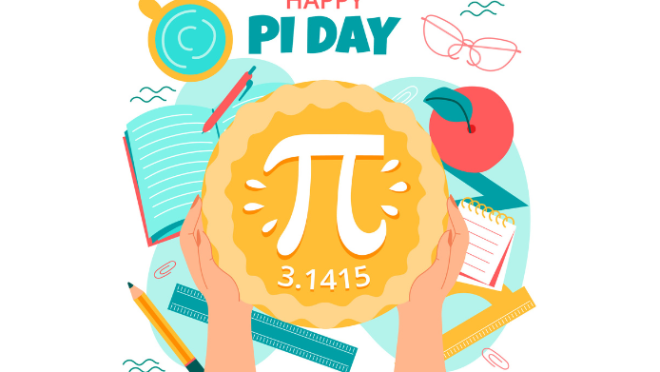Celebrating Pi Day: An incredibly beautiful number in mathematics!
Celebrating Pi Day: An incredibly beautiful number in mathematics!

3.1415926535897932384626433832795028841971693993751058209749445923078164062862089986280348253421170679…
Alright, let’s pause here before we run out of breath! These digits go on forever, but what exactly is this infinite number?
Meet pi (π)—one of mathematics’ most captivating constants. It’s the ratio of a circle’s circumference to its diameter, appearing everywhere from engineering and physics to the very fabric of the universe.
But Pi Day isn’t just about numbers—it’s also a day of scientific significance. 14 March marks the birth of Albert Einstein and the passing of Stephen Hawking. It’s also celebrated as the International Day of Mathematics, honouring the beauty of math in all its forms.
For now, though, let’s celebrate the most delightfully irrational number in existence—Happy Pi Day!
Why do we celebrate Pi Day?
Every year, on 14 March (3/14), math lovers across the world come together to celebrate Pi Day. But this isn’t just a day for number crunchers; it’s about appreciating the beauty of math and its impact on everything around us.
This year’s theme, “Mathematics, Art, and Creativity,” highlights how math shapes our world in ways we often overlook.
What makes Pi so special?
Pi (π) is irrational—not because it makes no sense (we promise it does!), but because its digits go on forever without repeating. The first three, 3.14, give Pi Day its date. But did you know? Mathematicians have calculated trillions of pi’s digits using supercomputers!
The Greek letter π was first used for pi in the 1700s, likely as an abbreviation for “periphery” or “perimeter.” Pretty fitting, right?
How is pi calculated?
Pi is a special type of number in mathematics—it is irrational and never-ending. An irrational number cannot be expressed as a fraction or ratio of two integers. Despite this, there are some close approximations of pi, including 22/7 (3.1428571) and 355/113 (3.1415929).
For thousands of years, mathematicians have been on a mission to more accurately calculate the value of pi. Greek mathematician Archimedes was one of the first to calculate an accurate approximation of pi by adding more and more sides to a polygon drawn within a circle. Using this technique, Archimedes showed that π is between 3 1/7 and 3 10/71.
How to celebrate Pi Day (without doing math)
You don’t have to be a mathematician to enjoy Pi Day! Here are some fun ways to join in:
- Eat circular foods – Pizza, pie, pancakes—if it’s round, it’s Pi Day-approved!
- Memorise Pi – Think you have a great memory? The world record for memorising pi is 70,000 digits! Can you beat it? (Okay, maybe just aim for 10.)
- Create Pi-inspired art – Draw spirals, make paper chains with pi’s digits, or even bake a pie with “π” on top.
- Tell Pi jokes – Like this one:
Why should you never start a conversation with pi?
Because it just goes on forever!
Some cool facts about pi
- There are no zeros until the first 31 digits in the calculation of pi.
- The first 6 digits of pi 314159, appear in the same sequence at least 6 times in 10 million decimal places of pi.
- The calculation of pi has been done to millions of digits, but the number 123456 does not occur in sequence anywhere.
- The calculation of pi has also been calculated as the stress test for a computer.
- The accurate value of pi can never be calculated since the calculation just goes on. Therefore, the accurate circumference of a circle can also never be calculated.
Now, let’s end with some pi jokes (because Pi Day wouldn’t be complete without them!):
- What was Sir Isaac Newton’s favourite dessert?
Apple pi. - Did you know that 3.14% of sailors are…?
Pi-rates! - What’s a mathematician’s favourite snake?
A pi-thon. - What’s a pie without a pi?
2.71 (That’s e, another famous irrational number!)


